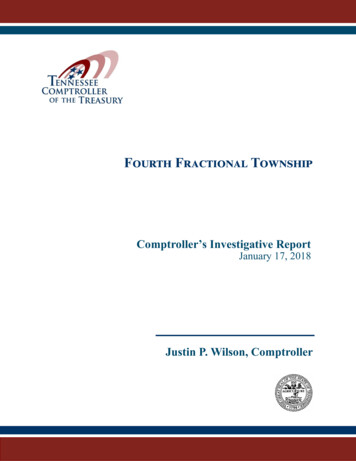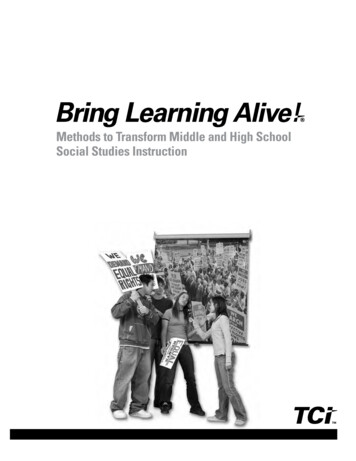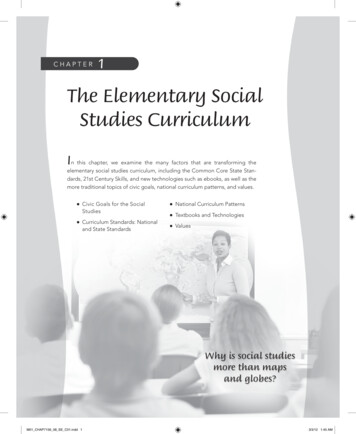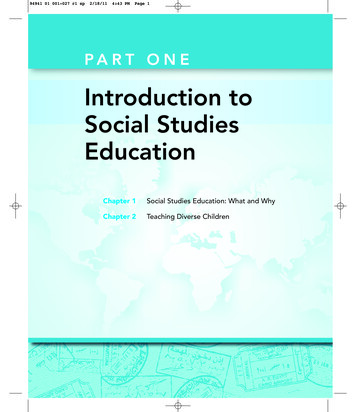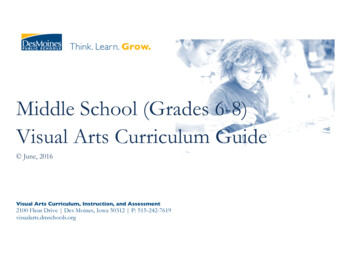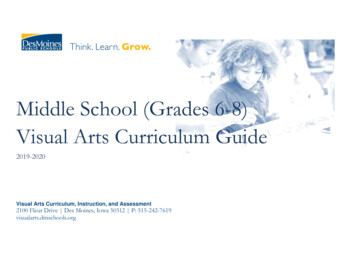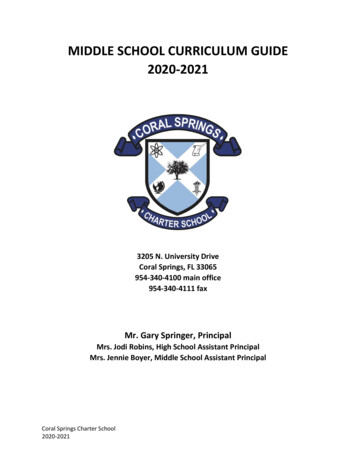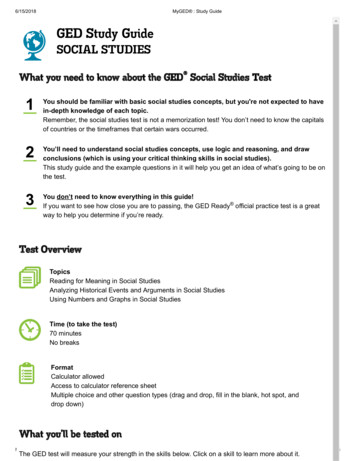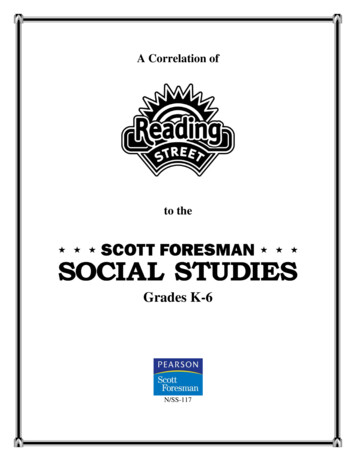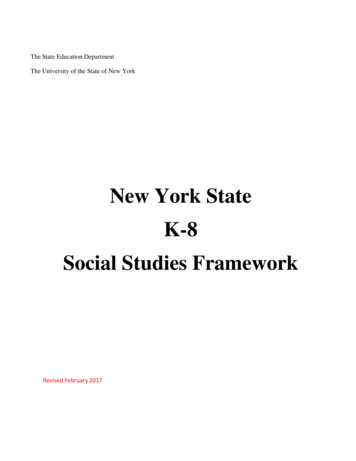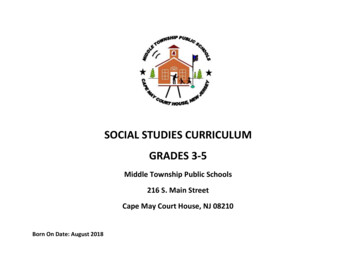
Transcription
SOCIAL STUDIES CURRICULUMGRADES 3-5Middle Township Public Schools216 S. Main StreetCape May Court House, NJ 08210Born On Date: August 2018
Grade 3Communities and Our Human GeographyCitizens and GovernmentExpressions of Culture
Grade 3 Social Studies Scope and SequenceUnitMonthsEstimated PacingUnit 1: Communities and OurHuman GeographySeptember-December30 daysUnit 2: Citizens and GovernmentDecember-March31 daysUnit 3: Expressions of Culture(Aligned with Reading and WritingUnits: Learning Through Reading:Countries around the World,Changing the World:April-June30 daysPersuasive Speeches Petitions andEditorials andBiography Book Clubs)
Grade ThreeUnit 1Communities and Our Human Geography
Content Area:Social StudiesUnit Plan Title:Communities and Our Human GeographyUnit Goal:Students will understand how communities are unique and have different geographies, histories, and jobs.Standard(s) Number and Description (Established Goals)Grade(s) 3
Standards:New Jersey Student Learning Standards for Social Studies:6.1 U.S. History: America in World: All students will acquire the knowledge and skills to think analytically about how past and present interactions of people, cultures, and the environmentshape the American heritage. Such knowledge and skills enable students to make informed decisions that reflect fundamental rights and core democratic values as productive citizens inlocal, national, and global communities.6.1.4.A.1 Explain how rules and laws created by community, state, and national governments protect the rights of people, help resolve conflicts, and promote the common good.6.3.4.B.1 Plan and participate in an advocacy project to inform others about environmental issues at the local or state level and proposes possible solutions6.1.4.B.2 Use physical and political maps to explain how the location and spatial relationship of places in New Jersey, the United States, and other areas, worldwide, have contributed tocultural diffusion and economic interdependence.6.1.4.B.3 Explain how and when it is important to use digital geographic tools, political maps, and globes to measure distances and to determine time zones and locations using latitude andlongitude.6.1.4.B.4 Describe how landforms, climate and weather, and availability of resources have impacted where and how people live and work in different regions of New Jersey and the UnitedStates.6.1.4.B.5 Describe how human interaction impacts the environment in New Jersey and the United States.6.1.4.B.8 Compare ways people choose to use and divide natural resources.6.1.4.B.10 Identify major cities in New Jersey, as well as in the United States, and the world, and explain how geographic and demographic tools (e.g., maps, globes, data visualizations) canbe used to understand cultural differences.6.1.4.C.14 Compare different regions of New Jersey to determine the role that geography, natural resources, climate, transportation technology, and/or the labor force play in economicopportunities.6.1.4.D.11 Determine how local and state communities have changed over time, and explain the reasons for changes.6.3 Active Citizenship in the 21st century: All Students will acquire the skills needed to be active, informed citizens who value diversity and promote cultural understanding by workingcollaboratively to address the challenges that are inherent in living in an interconnected world.6.3.4.A.1 Determine what makes a good rule or law and apply this understanding to rules and laws in your school or community (e.g., bike helmet, recycling).6.3.4.A.2 Examine the impact of a local issue by considering the perspectives of different groups, including community members and local officials.New Jersey Student Learning Standards:Reading Standards for Informational Text:RI.3.1 Ask and answer questions, and make relevant connections to demonstrate understanding of a text, referring explicitly to the text as the basis for the answers.RI.3.2 Determine the main idea of a text; recount the key details and explain how they support the main idea.RI.3.3 Describe the relationship between a series of historical events, scientific ideas or concepts, or steps in technical procedures in a text, using language that pertains to time, sequence,and cause/effect.RI.3.4 Determine the meaning of general academic and domain-specific words and phrases in a text relevant to a grade 3 topic or subject area.RI.3.5 Use text features and search tools to locate information relevant to a given topic efficiently.RI.3.6 Distinguish their own point of view from that of the author of a text.RI.3.7 Use information gained from text features(e.g., illustrations, maps, photographs) and the words in a text to demonstrate understanding of the text (e.g., where, when, why, and howkey events occur).RI.3.8 Describe the logical connection between particular sentences and paragraphs in a text (e.g., comparison, cause/effect, first/second/third in a sequence) to support specific points theauthor makes in a text.RI.3.9 Compare, contrast and reflect on (e.g. practical knowledge, historical/cultural context, and background knowledge) the most important points and key details presented in two textson the same topic.RI.3.10 By the end of the year, read and comprehend literary nonfiction at grade level text-complexity or above, with scaffolding as needed.Writing Standards:W.3.1. Write opinion pieces on topics or texts, supporting a point of view with reasons. (a-d)W.3.2 Write informative/explanatory texts to examine a topic and convey ideas and information clearly. (a-d)W.3.7 Conduct short research projects that build knowledge about a topic.W.3.8 Recall information from experiences or gather information from print or digital sources; take brief notes on sources and sort evidence into provided categories.New Jersey Core Curriculum Content Standards- Technology
8.1.5.A.1- Select and use the appropriate digital tools and resources to accomplish a variety of tasks including solving problems.8.1.5.D.3- Demonstrate an understanding of the need to practice cyber safety, cyber security, cyber security, and cyber ethics when using technologies and social media.Career Ready Practices:CRP1 Act as a responsible and contributing citizen and employeeCRP6 Demonstrate creativity and innovationCRP11 Use technology to enhance productivityCRP12 Work productively in teams while using cultural global competenceEnduring Understandings:The world is comprised of nations that are similar to and different from the United States.Places are jointly characterized by their physical and human properties.Spatial thinking and geographic tools can be used to describe and analyze the spatial patterns and organization of people, places, and environments on Earth.The physical environment can both accommodate and be endangered by human activities.Regions form and change as a result of unique physical/ecological conditions, economies, and cultures.Are aware of their relationships to people, places, and resources in the local community and beyond.Urban areas, worldwide, share common physical characteristics, but may also have cultural differences.We all have relationships to people, places, and resources in the local community and beyond.Students will Explain cardinal and intermediate directions on a map’s compass rose.Identify and use a map scale.Use geographic tools to locate communities.Use hemisphere, and equator to find locations.Understand relative location.Locate places using latitude and longitude.Recognize and describe physical characteristics of places.Identify landforms, climates, and vegetation of communities.Identify and explain the purpose and elements of landform maps.Identify the physical features of communities in the United States.Identify the five geographical regions of the United States.Understand the natural disasters can change the environment.Recognize and identify that people modify the environment to meet basic needs.Recognize how people can negatively affect the environment and can care for it.Understand the characteristics and purposes of a road map.Understand how to use a road map and write directions to get from one location to another.Understand that a population map shows patterns of settlement.
Recognize that a population density shows the number of people living in a given area.Read, interpret, and draw land use and product maps.Explain why countries import and exports goods.Identify how transportation has improved the quality of goods and services.Essential Questions How do people make choices about using natural resources?How does the type of community you live in (rural, urban, suburban) affect the way you interact with environment (five themes of geography)?What can various types of maps, globes and other sources tell us about the states and regions of the U.S.?Suggested Student Learning Activities & Assessments: Reader’s Theatre RAFT Choice Boards Make a picture Dictionary/Vocabulary Cards Poster/PowerPoint Projects Writing a Poem Create a physical map of your community Construct a poster of what makes your community special Design a park Write a persuasive essay to the Mayor/Governor suggesting improvements to your community/State Create a pamphlet to highlight ways to use our school or community resources more effectively Conduct short research projects with a culminating opinion or informative piece of writing Create map symbols on a given map Open-ended questions based upon essential questions Tests and Quizzes Suggested Resources and Reading MaterialsWe Live in Communities, People and the Land, Sister Cities, Chill Out!, Communities of the Future, New Frontiers Classroom and interactive maps and globesRead Aloud: The Little House by Virginia Burton Read Aloud: Me on the Map by Joan SweeneyRead Aloud: Mapping Penny’s World by Loreen Leedy Reading a Map lessons.Grade Three
Unit 2Citizens and GovernmentContent Area:Social StudiesUnit Plan Title:Citizens and GovernmentGrade(s) 3
Unit Goal:Students will understand the rights and responsibilities of a government and its citizens.Standard(s) Number and Description (Established Goals)Standards:New Jersey Student Learning Standards for Social Studies:6.1 U.S. History: America in the World All students will acquire the knowledge and skills to think analytically about how past and present interactions of people, cultures, and theenvironment shape the American heritage. Such knowledge and skills enable students to make informed decisions that reflect fundamental rights and core democratic values as productivecitizens in local, national, and global communities.6.1.4.A.12 Explain the process of creating change at the local, state, or national level.6.1.4.C.6 Describe the role and relationship among households, businesses, laborers, and governments within the economic system.6.1.4.C.9 Compare and contrast how the availability of resources affects people across the world differently.6.1.4.C.10 Explain the role of money, savings, debt, and investment in individuals’ lives.6.1.4.C.11 Recognize the importance of setting long-term goals when making financial decisions within the community.6.1.4.C.12 Evaluate the impact of ideas, inventions, and other contributions of prominent figures who lived in New Jersey.6.1.4.C.15 Describe how the development of different transportation systems impacted the economies of New Jersey and the united States6.1.4.C.16 Explain how creativity and innovation resulted in scientific achievement and inventions in many cultures during different historical periods.6.1.4.D.5 Relate key historical documents (i.e., the Mayflower Compact, the Declaration of Independence, the United States Constitution, and the Bill of Rights) to present day governmentand citizenship.6.1.4.D.6 Describe the civic leadership qualities and historical contributions of George Washington, Thomas Jefferson, and Benjamin Franklin toward the development of the United statesgovernment.6.3 Active Citizenship in the 21st century: All Students will acquire the skills needed to be active, informed citizens who value diversity and promote cultural understanding by workingcollaboratively to address the challenges that are inherent in living in an interconnected world.6.3.4.A.4 Communicate with students from various countries about common issues of public concern and possible solutions.New Jersey Student Learning Standards:Reading Standards for Informational Text:RI.3.1 Ask and answer questions, and make relevant connections to demonstrate understanding of a text, referring explicitly to the text as the basis for the answers.RI.3.2 Determine the main idea of a text; recount the key details and explain how they support the main idea.RI.3.3 Describe the relationship between a series of historical events, scientific ideas or concepts, or steps in technical procedures in a text, using language that pertains to time, sequence,and cause/effect.RI.3.4 Determine the meaning of general academic and domain-specific words and phrases in a text relevant to a grade 3 topic or subject area.RI.3.5 Use text features and search tools to locate information relevant to a given topic efficiently.RI.3.6 Distinguish their own point of view from that of the author of a text.RI.3.7 Use information gained from text features(e.g., illustrations, maps, photographs) and the words in a text to demonstrate understanding of the text (e.g., where, when, why, andhow key events occur).RI.3.8 Describe the logical connection between particular sentences and paragraphs in a text (e.g., comparison, cause/effect, first/second/third in a sequence)to support specific points theauthor makes in a text.RI.3.9 Compare, contrast and reflect on (e.g. practical knowledge, historical/cultural context, and background knowledge) the most important points and key details presented in two textson the same topic.RI.3.10 By the end of the year, read and comprehend literary nonfiction at grade level text-complexity or above, with scaffolding as needed.Writing Standards:W.3.1. Write opinion pieces on topics or texts, supporting a point of view with reasons. (a-d)W.3.2 Write informative/explanatory texts to examine a topic and convey ideas and information clearly. (a-d)W.3.7 Conduct short research projects that build knowledge about a topic.W.3.8 Recall information from experiences or gather information from print or digital sources; take brief notes on sources and sort evidence into provided categories.New Jersey Core Curriculum Content Standards- Technology8.1.5.A.1- Select and use the appropriate digital tools and resources to accomplish a variety of tasks including solving problems.8.1.5.D.3- Demonstrate an understanding of the need to practice cyber safety, cyber security, cyber security, and cyber ethics when using technologies and social media.Career Ready Practices:
CRP1 Act as responsible and contributing citizen and employeeCRP5 Consider the environmental, social and economic impacts of decisionsCRP6 Demonstrate creativity and innovationCRP11 Use technology to enhance productivityCRP12 work productively in teams while using cultural global competenceEnduring Understandings: There are different branches within the United States government, each with its own structure, leaders, and processes, and each designed to address specific issues and concerns.American constitutional government is based on principles of limited government, shared authority, fairness, and equality.In a representative democracy, individuals elect representatives to act on the behalf of the people.Economics is a driving force for the occurrence of various events and phenomena in societies.Interaction among various institutions in the local, national, and global economies influences policy making and societal outcomes.Financial instruments and outcomes assist citizens in making sound decisions about money, savings, spending, and investment.Creativity and innovation affect lifestyle, access to information, and the creation of new products and services.Economic opportunities in New Jersey and other states are related to the availability of resources and technology.Creativity and innovation have led to improvements in lifestyle, access to information, and the creation of new products.Rules and laws are developed to protect people’s rights and the security and welfare of society.The United States Constitution and Bill of Rights guarantee certain fundamental rights for citizens.The United States democratic system requires active participation of its citizens.Students will Understand that citizens are part of a community and culture.Explain how people in a community depend on one another.Recognize that communities use rules and laws to keep people safeIdentify how people in different communities communicate with each other.Explain how nations help each other.Recognize that people have different perspectives concerning communitiesUnderstand and apply some basic rights of citizens, including the freedoms of religion, speech, press, and assembly.Identify and explain the voting process.Understand that citizens have responsibilities.Describe the traits of a good citizen.Identify people in history who have been good citizensIdentify and describe the three branches of the national government.Explain the basic types, purposes, and structures of city and county governments.Identify goods and services that local governments provide.Describe the features of state and national government and its leaders.Explain how certain documents symbolize our nation.Understand the importance of entrepreneurship.Identify how technology has changed the economy of communities worldwide.
Essential Questions What is scarcity and opportunity cost, and how do those concepts influence my economic decision-making?How are producers and consumers around the world interconnected (markets)?What makes prices go up and down (supply and demand, productivity)?Suggested Student Learning Activities & Assessments: Reader’s Theatre Make a picture Dictionary/Vocabulary Cards RAFT Choice Boards Poster/PowerPoint Project Skill builder activities Read and analyze primary source documents Conduct a short research project with a culminating opinion, informative or explanatory piece of writing Open-ended questions based on essential questions Tests and QuizzesSuggested Resources and Reading MaterialsCitizens Lead the Way, Making Money/Saving Money, Designing our Capital, Designing Currency, People who Care, Risky Business www.nationalgeographic.com Read Aloud: Shh! We’re Writing the Constitution by Jean Fritz Read Aloud: If You Were There When They Signed the Constitution by Elizabeth Levy Read Aloud: WE THE KIDS: The Preamble to the Constitution of the United States by David Catrow archives.gov website for primary sourcesUnit 3
Expressions of CultureAligned with Reading and Writing Units:Learning Through Reading: Countries around the WorldChanging the World: Persuasive Speeches Petitions and EditorialsBiography Book ClubsContent Area:Social StudiesGrade(s) 3
Unit Plan Title:Expressions of CultureUnit Goal:Students will understand communities are alike and different and are found all over the world.Standard(s) Number and Description (Established Goals)Standards:New Jersey Student Learning Standards for Social Studies:6.1 U.S. History: America in the World All students will acquire the knowledge and skills to think analytically about how past and present interactions of people, cultures, and theenvironment shape the American heritage. Such knowledge and skills enable students to make informed decisions that reflect fundamental rights and core democratic values as productivecitizens in local, national, and global communities.6.1.4.A.9 Compare and contrast responses of individuals and groups, past and present, to violations of fundamental rights (e.g., fairness, civil rights, human rights).6.1.4.A.10 Describe how the actions of Dr. Martin Luther King, Jr., and other civil rights leaders served as catalysts for social change and inspired social activism in subsequent generations.6.1.4.A.11 Explain how the fundamental rights of the individual and the common good of the country depend upon all citizens exercising their civic responsibilities at the community, state,national, and global levels.6.1.4.A.13 Describe the process by which immigrants become United States citizens.6.1.4.A.14 Describe how the world is divided into many nations that have their own governments, languages, customs, and laws.6.1.4.A.15 Explain how and why it is important that people from diverse cultures collaborate to find solutions to community, state, national, and global challenges.6.1.4.B.10 Identify major cities in New Jersey, as well as in the United States, and the world, and explain how geographic and demographic tools (e.g., maps, globes, data visualizations) canbe used to understand cultural differences.6.1.4.C.18 Explain how the development of communications systems has led to increased collaboration and the spread of ideas throughout the United States and the world.6.1.4.D.2 Summarize reasons why various groups, voluntarily and involuntarily, immigrated to New Jersey and America, and describe the challenges they encountered.6.1.4.D.3 Evaluate the impact of voluntary and involuntary immigration on America’s growth as a nation, historically and today.6.1.4.D.13 Describe how culture is expressed through and influenced by the behavior of people.6.1.4.D.14 Trace how the American identity evolved over time.6.1.4.D.15 Explain how various cultural groups have dealt with the conflict between maintaining traditional beliefs and practices and adopting new beliefs and practices.6.1.4.D.16 Describe how stereotyping and prejudice can lead to conflict, using examples from the past and present.6.1.4.D.17 Describe how stereotyping and prejudice can lead to conflict, using examples from the past and present.6.1.4.D.18 Explain how an individual’s beliefs, values, and traditions may reflect more than one culture.6.1.4.D.19 Explain how experiences and events may be interpreted differently by people with different cultural or individual perspectives.6.1.4.D.20 Describe why it is important to understand the perspectives of other cultures in an interconnected world.6.3 Active Citizenship in the 21st century: All Students will acquire the skills needed to be active, informed citizens who value diversity and promote cultural understanding by workingcollaboratively to address the challenges that are inherent in living in an interconnected world.6.3.4.A.4 Communicate with students from various countries about common issues of public concern and possible solutions.New Jersey Student Learning Standards:Reading Standards for Informational Text:RI.3.1 Ask and answer questions, and make relevant connections to demonstrate understanding of a text, referring explicitly to the text as the basis for the answers. RI.3.2 Determine themain idea of a text; recount the key details and explain how they support the main idea.RI.3.3 Describe the relationship between a series of historical events, scientific ideas or concepts, or steps in technical procedures in a text, using language that pertains to time, sequence,and cause/effect.RI.3.4 Determine the meaning of general academic and domain-specific words and phrases in a text relevant to a grade 3 topic or subject area.RI.3.5 Use text features and search tools to locate information relevant to a given topic efficiently.RI.3.6 Distinguish their own point of view from that of the author of a text.RI.3.7 Use information gained from text features (e.g., illustrations, maps, photographs) and the words in a text to demonstrate understanding of the text (e.g., where, when, why, and howkey events occur)RI.3.8 Describe the logical connection between particular sentences and paragraphs in a text (e.g., comparison, cause/effect, first/second/third in a sequence)to support specific points theauthor makes in a text.RI.3.9 Compare, contrast and reflect on (e.g. practical knowledge, historical/cultural context, and background knowledge) the most important points and key details presented in two textson the same topic.RI.3.10 By the end of the year, read and comprehend literary nonfiction at grade level text-complexity or above, with scaffolding as needed.
Writing Standards:W.3.1. Write opinion pieces on topics or texts, supporting a point of view with reasons. (a-d)W.3.2 Write informative/explanatory texts to examine a topic and convey ideas and information clearly. (a-d)W.3.7 Conduct short research projects that build knowledge about a topic.W.3.8 Recall information from experiences or gather information from print or digital sources; take brief notes on sources and sort evidence into provided categories.New Jersey Core Curriculum Content Standards- Technology8.1.5.A.1- Select and use the appropriate digital tools and resources to accomplish a variety of tasks including solving problems.8.1.5.D.3- Demonstrate an understanding of the need to practice cyber safety, cyber security, cyber security, and cyber ethics when using technologies and social media.Career Ready Practices:CRP6 Demonstrate creativity and innovationCRP7 Employ valid and reliable research strategiesCRP8 Utilize critical thinking to make sense of problems and persevere in solving themCRP11 Use technology to enhance productivityCRP12 work productively in teams while using cultural global competenceEnduring Understandings: Recognize that people have different perspectives based on their beliefs, values, traditions, culture and experiences.Patterns of settlement across Earth’s surface differ markedly from region to region, place to place, and time to time.Advancements in science and technology can have unintended consequences that impact individuals and/or societies.Students will Recognize literature, art, music, dance, architecture, and religion as expressions of culture.Compare and contrast cultural holidays, language, dress, and food.Define cultural identity.Explain how certain symbols are associated with values of United States history and government.Identify various monuments and memorials and what they symbolize.Identify reasons why people move to new places and within a country.Describe immigrants’ arrival and living conditions in the United States.Compare and contrast cultures and diversity in communities.Explain significance of national holidays and landmarks.Essential Questions How do people make positive change in their communities?People can express their culture in many waysWhat is the majority/minority group in a community, and how do they interact?How have various cultures around the world utilized or adapted their environment to address needs and wants?What is an American?What has influenced the development of American culture?
Suggested Student Learning Activities & Assessments: Reader’s Theatre RAFT Choice Boards Make a picture Dictionary/Vocabulary Cards Poster/powerPoint Project Research students country of origin Research how cultures and communities celebrate holidays around the world Research and create an informational pamphlet for the different cultures studied Conduct a short research project with a culminating opinion, informative or explanatory piece of writing Open-ended questions based upon the essential questions Tests and Quizzes Writing pre and post assessments can be utilized during this unitSuggested Resources and Reading MaterialsLeveled Readers:Community HistoryPeople from Many PlacesOur Sturbridge VillageThe Nation’s Attic: The SmithsonianFrozen in TimeShaking Things Up: Cultural Revolutions Videos on Pilgrims and MayflowerRead Aloud: A Place Called Freedom by Scott Russell SandersRead Aloud: If Your Name was Changed at Ellis IslandRead Aloud: The Name Jar by Yangsook ChoiRead Aloud: Grandfather’s Journey by Allen SayRead Aloud: Martin’s Big Words written by Doreen RappaportRead Aloud: “Who Was” series: Martin Luther King Jr., Rosa Parks, Harriet Tubman, Abraham LincolnRead Aloud: Henry’s Freedom Box written by Ellen LevineRead Aloud: One Green Apple by Eve BuntingEllis Island virtual webquestClose Read: “Dances Around the World”
Grade 4GeographyNatural ResourcesGovernmentEconomyRegionsCitizenship
Grade 4 Social Studies Scope and SequenceUnitMonthsEstimated PacingUnit 1: GeographySeptember/October14 daysUnit 2: Natural ResourcesOctober/November/December15 daysUnit 3: GovernmentDecember/January18 daysUnit 4: EconomyFebruary/March12 daysUnit 5: RegionsMarch/April15 daysUnit 6: CitizenshipMay/June16 days
Grade FourUnit 1Geography
Content Area:Social StudiesUnit Plan Title:GeographyUnit Goal:Students will utilize various geographic tools to understand the world around them.Grade(s) 4Standard(s) Number and Description (Established Goals)Standards:New Jersey Student Learning Standards for Social Studies:6.1 U.S. History: America in the WorldAll students will acquire the knowledge and skills to think analytically about how past and present interactions of people, cultures and the environment shape the American heritage. Suchknowledge and skills enable students to make informed decisions that reflect fundamental rights and core democratic values as productive citizens in local, national and global communities.6.1.4.B.1 - Compare and contrast information that can be found on different types of maps and determine how the information may be useful.6.1.4.B.3 - Explain how and when it is important to use digital geographic tools, political maps, and globes to measure distances and to determine time zones and locations using latitudeand longitude.New Jersey Student Learning Standards:Reading Standards for Informational Text:RI.4.1 Refer to details and examples in a text and make relevant connections when explaining what the text says explicitly and when drawing inferences from the text.RI.4.2 Determine the main idea of a text, and expla
SOCIAL STUDIES CURRICULUM GRADES 3-5 Middle Township Public Schools 216 S. Main Street Cape May Court House, NJ 08210 Born On Date: August 2018 . Grade 3 Communities and Our Human Geography Citizens and Government Expressions of Culture . Grade 3 Social Studies Scope and Sequence U
